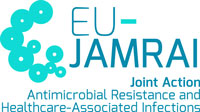Step by step guide for the implementation and assessment of LMS-based Online Learning
LMS-based Online Learning involves the delivery, tracking, management, and assessment of structured educational courses and diverse learning materials focused on AMR/AMS through a dedicated software application known as a Learning Management System (LMS) or Virtual Learning Environment (VLE). These platforms facilitate access to modular content, often allowing for self-paced learning, and can support various interactive elements, assessments, and learner progress monitoring.

Planning a LMS-based Online Learning
The following steps should be taken into consideration when planning LMS-based Online Learning on AMR/AMS:
- Curriculum Design and Objective Setting: Clearly define target professional audiences (e.g., veterinarians, hospital pharmacists, medical students) and specific learning objectives for AMR/AMS competencies to be achieved. (Allerton and Russell, 2023, review various online veterinary AMS courses with defined aims).
- Content Development and Curation: Create or curate a rich variety of digital learning materials. This can include interactive modules with text and graphics, video lectures, animations, branched-logic clinical case simulations (MacDougall et al., 2017), gamified elements or serious games (Sørensen et al., 2018), downloadable readings (guidelines, articles), self-assessment quizzes, and links to external AMR/AMS resources. (Armas Freire et al., 2022, list theoretical content, clinical cases, videos, and supplementary readings; Laks et al., 2019, includes theoretical modules, exercises, and simulations).
- Modular Course Structuring: Organize the content logically into manageable modules or units within the LMS, often allowing for sequential progression or flexible access depending on the course design. (Most online courses reviewed, such as those in Allerton and Russell, 2023, and Sneddon et al., 2018, adopt a modular structure).
- LMS Setup and Enrollment: Configure the course within the chosen LMS platform. Manage participant enrollment, provide clear instructions for system access, navigation, and completion requirements.
- Learner Engagement and Interaction: Incorporate features to promote learner engagement, which may include discussion forums for peer interaction or Q&A with tutors (Armas Freire et al., 2022), optional or required live online sessions for real-time discussion (Laks et al., 2019), and interactive exercises.
- Progress Monitoring and Support: Utilize LMS analytics to monitor participant progress, engagement levels, and identify learners who may need additional support. Provide clear channels for technical assistance and academic tutoring or facilitation for content-related queries. (Laks et al., 2019, mention tutored online activities).
- Content Maintenance and Updates: Regularly review and update course content to ensure it aligns with the latest evidence, AMR surveillance data, and AMS guidelines. (Allerton & Russell, 2023).
- Consider Blended Learning: LMS-based modules can serve as effective pre-work for subsequent face-to-face workshops or practical sessions, creating a blended learning experience. (MacDougall et al., 2017, used an online module prior to an interprofessional workshop).

Defining roles in a LMS-based Online Learning
Facilitator’s role (Course Administrator/Instructional Designer/Tutor): This role involves curriculum planning, instructional design, content creation or curation, organizing content within the LMS, managing course settings and enrollments, tracking learner progress, actively facilitating online discussions or live sessions (if included), providing timely and constructive feedback on assignments, and offering ongoing technical and academic support to learners. In online training programmes, this role is often distributed across multiple sub-roles, including course administration, technical support, instructional design, content development, and tutoring.
Participant’s role: Typically involves self-directed learning, although some courses may have set schedules. Participants are expected to log in to the LMS, navigate through the structured course materials, diligently engage with diverse multimedia content, complete required modules and activities, participate actively in any online interactions or collaborative tasks, and complete all assessments to demonstrate learning.

Assessing a LMS-based Online Learning
Methods
- Embedded online quizzes (e.g., multiple-choice questions, true/false, matching) with automated feedback to reinforce learning at the end of modules or sections. (Commonly used in most online courses, e.g., Sneddon et al., 2018; Allerton & Russell, 2023).
- Completion of interactive case studies or simulations with performance tracking.
- Submission of assignments (e.g., case analyses, short essays, project proposals) for facilitator or peer review.
- Assessed participation in LMS-based discussion forums, if required.
- Comprehensive final examinations or projects to evaluate overall understanding and application of AMR/AMS principles.
- Pre- and post-course knowledge and attitude assessments to measure learning gain and shifts in perception. (Laks et al., 2019; MacDougall et al., 2017; Armas Freire et al., 2022; Sørensen et al., 2018).
Tools
LMS-native quiz, assignment, and grading tools. Progress tracking dashboards and analytics. Automated feedback systems. Discussion forum monitoring tools. Plagiarism detection software. Issuance of certificates of completion or Continuing Professional Development (CPD) points upon successful course completion. (Allerton and Russell, 2023, note CPD certification for several courses).

Suggested LMS-based Online Learning prototype
Target Audience: Health Managers, Wastewater Managers, Clinical Profiles, Researchers, Educators.
Learning Objectives:
- Develop a comprehensive understanding of the drivers and consequences of AMR from a One Health perspective.
- Acquire in-depth knowledge of core AMS principles applicable to various healthcare or professional settings.
- Enhance skills in interpreting local AMR data, applying stewardship guidelines, and promoting rational antimicrobial use.
- Foster interprofessional understanding of roles and responsibilities in combating AMR.
Curriculum/Activities:
- A multi-module course (e.g., 8-10 modules, each requiring 2-4 hours of study) delivered via an LMS like Moodle or Canvas.
- Modules could include:
- The Global Threat of AMR: Epidemiology and Impact.
- Mechanisms of Resistance and Classes of Antimicrobials.
- Core Principles of Antimicrobial Stewardship (Diagnostics, Dose Optimization, De-escalation, Duration, IV-to-Oral Switch).
- Infection Prevention and Control in Limiting AMR Spread.
- AMR in Specific Settings (e.g., Human Health (Primary Care/Hospital), Animal Health, Environment – allowing for tailored pathways).
- Interpreting Antibiograms and Surveillance Data.
- Communication and Behavioral Aspects of AMS.
- One Health Approaches to AMR.
- Each module incorporates: video lectures from experts, interactive e-learning content (e.g., Articulate Storyline modules with branched scenarios as in MacDougall et al., 2017), gamified quizzes (as in Sørensen et al., 2018), downloadable guidelines and key research papers, and a moderated discussion forum for Q&A and peer interaction.
- A final project requiring participants to develop a mini-AMS action plan for their specific work context.
Evaluation of the Prototype’s Effectiveness:
- Analysis of course completion rates, module engagement, and performance on quizzes/assignments via LMS analytics.
- Significant improvements in pre- vs. post-course knowledge and attitude scores. (Laks et al., 2019, and Armas Freire et al., 2022, demonstrated knowledge gain).
- High user satisfaction ratings regarding course content quality, platform usability, interactivity, relevance to practice, and flexibility of online learning. (Sørensen et al., 2018, reported positive user perception).
- Quality of final AMS action plan projects.
- Longer-term (if feasible): Follow-up surveys or audits to assess self-reported or observed changes in AMR/AMS related practices or decision-making in the workplace (Kirkpatrick Level 3).
References
- Allerton, F., & Russell, J. (2023). Antimicrobial stewardship in veterinary medicine: A review of online r esources. JAC-Antimicrobial Resistance, 5(3). https://doi.org/10.1093/jacamr/dlad058
- Armas Freire, P. I., Gaspar, G. G., Zurita, J., Salazar, G., Velez, J. W., & Bollela, V. R. (2022). E-Learning versus Face-to-Face Methodology for Learning Antimicrobial Resistance and Prescription Practice in a Tertiary Hospital of a Middl e-Income Country. Antibiotics, 11(12), 1829. https://doi.org/10.3390/antibiotics11121829
- Laks, M., Guerra, C. M., Miraglia, J. L., & Medeiros, E. A. (2019). Distance learning in antimicrobial stewardship: Innovation in medical education. BMC Medical Education, 19, 191. https://doi.org/10.1186/s12909-019-1623-x
- MacDougall, C., Schwartz, B. S., Kim, L., Nanamori, M., Shekarchian, S., & Chin-Hong, P. V. (2017). An Interprofessional Curriculum on Antimicrobial Stewardship Improves Knowledge and Attitudes Toward Appropriate Antimicrobial Use and Collaboration. Open Forum Infectious Diseases, 4(1), ofw225. https://doi.org/10.1093/ofid/ofw225
- Rocha-Pereira, N., Lafferty, N., & Nathwani, D. (2015). Educating healthcare professionals in antimicrobial stewardship: Can online-learning solutions help? Journal of Antimicrobial Chemotherapy, 70(12), 3175–3177. https://doi.org/10.1093/jac/dkv336
- Sneddon, J., Barlow, G., Bradley, S., Brink, A., Chandy, S. J., & Nathwani, D. (2018). Development and impact of a massive open online course (MOOC) for anti microbial stewardship. Journal of Antimicrobial Chemotherapy, 73(4), 1091–1097. https://doi.org/10.1093/jac/dkx493
- Sørensen, A. H., Jensen-Fangel, S., Svendstrup, D. B., Kjaersgaard, M., & Ank, N. (2018). Gamified e-learning course: A way to prudent use of antibiotics. MedEdPublish, 7, 99. https://doi.org/10.15694/mep.2018.0000099.1
